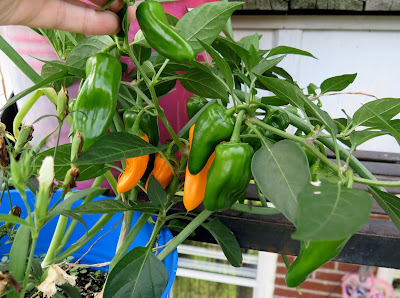If you have ever worked a piece in round, you may be familiar with laddering. It happens to many knitters, especially when working on a small piece, both on double pointed needles and circular needles (using the magic loop technique). The problem is caused by the changes in tension, which happens at the same column every round.
I usually don't get too much laddering on my project. I think my tension is pretty constant now and it helps a lot for that. The occasional ladder I get is often subtle enough that it doesn't bother me. And if I'm using wool yarn, I don't mind it too much, because washing and blocking the piece will most likely get rid of it. Cotton yarn on the other hand is a tricky one...
Nearly two years ago, I started this cardigan. I don't know why, but they don't sell the pattern anymore. Anyway, I like the look, and the sizing seems good so far. Actually, it's nearly finished, I only need to knit the collar part. But, you've guess it, it has a MAJOR laddering problem. I've never experienced this much laddering on a project. I think it's due to a combinations of factors.
First, the yarn. It's knitted it in comfy yarn which is 100% cotton. Don't get me wrong, I love this yarn. It super soft and is really nice to work with. I chose cotton because it's the perfect fiber for a light summer garment, which my wardrobe lacks. But cotton is known to be less resilient than wool.
Second, my technique. As I said, I've never had such a big laddering problem. At the time, my first instinct was to pull tighter on the yarn to make the bridge between these stitches shorter. It just seems intuitive, but it's NOT the way to go. By pulling the yarn, I worsened the difference in tension and likely made the problem more apparent.
Third, my laziness. If I had taken a couple of minutes to make some research, I would have find many videos showing me how to avoid that severe laddering. There are many ways you can improve your technique that will prevent this (using five double pointed needles instead of four, practicing to improve tension, moving stitches around so the first and last stitch of a needle aren't always the same etc).
Now that I know more about laddering, I won't make the same mistakes again. But what I need now is a way of fixing these ugly ladders, other than unraveling and starting over! I've looked around and haven't find much on the subject. Many mention washing and blocking as a way of diminishing the appearance of ladders, but I knew my cardigan needed more than that.
After a bit of trial and error, I have found a way to work the excess yarn back into the surrounding stitches. I will show you how I do it, in hopes it can be useful to some of you out there!
The only things you need for this technique are: a lot of patience and a tool of your choice (small crochet hook, small knitting needle or darning needles are all good options). All you need to do really, is to pull the yarn slowly away from the ladder to spread the excess material.
Using a pointy tool, pick up the "bridge" of yarn between the first and second stitches next to the ladder. If you were to look at the wrong side of the garment, you would see that this little bit of yarn is actually the bumpy part of a purl stitch.
Pull gently towards you and away from the ladder. You won't get rid of the laddering right away so don't worry about the look right now, and don't pull too tight at first.
See how it doesn't seem to fix anything? But don't worry, you just have to keep at it!
Once you've pull some yarn out between the first and second stitch, you have to spread it between the stitches to its right (or left if you are working on the other side of the ladder).
Repeat the same process of pulling the little bit of yarn between the stitches. The more you move away from the ladder, the less you should pull the yarn. This way, you leave a little extra yarn in each stitch. Three or four stitches (less if you started with a more subtle ladder) should be enough to spread the excess material you pull from the first "bridge". Once you are done on a side of the ladder, repeat the exercise on the other side.
That's what I got after my first "pass". Still a big ladder, but a bit better than what I started with.
This is after second complete cycle of spreading the excess yarn. It looks kind of worst at this point, don't you think?
Third pass completed, you can really see the improvement now. After that, I keep doing it a bit more, but washing and blocking at this point would probably fix the rest.
This is another part I did. You can compare with the upper part that is not fixed. It's still a bit noticeable, but as I said, washing and blocking will also help.
Have you experience such laddering in the past? I sure hope this tip was useful to you!




















































